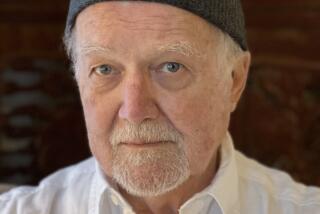The Story Is Fictional, but Its Horror Is Real
- Share via
This stunning novel about the 1943 uprising of prisoners at Treblinka is the work of Ian MacMillan, a writer who teaches at the University of Hawaii. Anyone who doubts that a work of literary art can sometimes come closer to the truth than the report of an eyewitness should read this novel. In the same kind of imaginative leap that enabled Stephen Crane to render an amazingly vivid and truthful account of a Civil War that was over before he was born, MacMillan has envisioned the far harder-to-imagine world of the Nazi death camps.
Some of the characters in this novel are based on real people. Most, however, are the extraordinarily lifelike creations of the novelist’s imagination. Through their eyes, MacMillan provides a searing, multidimensional and unforgettable picture of hell on Earth.
There’s Voss, an alcoholic SS officer, who has little compassion for the victims but is nonetheless shocked by the icy sadism of some of his fellow officers. There’s the Ukrainian guard Anatoly, looking for a way to run off with Magda, a local Polish girl whose family has disowned her for becoming pregnant with his child.
Clutching his paintbrushes and canvases as the overcrowded train rushes eastward, Yzak Berilman, a young artist, tries to look on the bright side of his forced “relocation.” He is resourceful, intelligent, cautiously optimistic. He assumes “the Germans need people to populate their conquered lands and to sing . . . the praises of the conquerors.” But none of his logical notions bears any relation to the ghastly reality.
On another train with his grandmother and four younger siblings is Janusz Siedlecki, 14. His grandmother has heard the rumors. Her hope is to shield her grandchildren from the truth as long as possible. Singled out by the Nazis to be one of the small group that is forced to dispose of the mountains of dead bodies, Janusz soon realizes he will never see his family again. MacMillan brilliantly conveys what it is like to live in an unabated state of shock: the sense of terror and grief lurking beneath the numbness that enables the boy to get through another day.
At first he cannot take in what has happened. He “imagines their faces, Grandmother, then . . . the little ones, and sees them in a kind of rapid animation. But they are dead. He does not know what to think of that.” The full impact hits him days later. His grief is intensified by feelings of guilt over having been rude to his grandmother on the train ride. Suddenly, he comprehends: “The children are dead, . . . and Grandmother--she is dead, and he did not say good-bye to her. In fact he behaved badly to her, and now she and the children are dead. He is alone, tiny and soiled and locked in this room, only a day or so away from his own death. His awareness has achieved so horrible a lucidity he feels he may vomit his insides out at his feet. The children are dead and he behaved so badly, and now he can never put it right.”
Janusz proves a hero, not only in risking his life to help the planned revolt, but also in the generosity of spirit he displays, giving away extra bits of food to his co-workers.
“Village of a Million Spirits” is the third novel that MacMillan has written on this daunting and heartbreaking subject. He has gone from strength to strength. This novel, despite the chaotic senselessness of the world it depicts, has a coherence and a unity that grow clearer as one reads on. Not the least of MacMillan’s accomplishments is his writing: spare, deliberate, with a gravity of tone that befits the subject.
We live in an age when it’s fashionable to harbor doubts about the reliability of texts. Everything is seen as capable of having been “fabricated.” MacMillan’s achievements in this novel are to affirm the truth of history against “revisionists” and to use imaginative art to render the horror with a vividness sometimes missing from factual accounts.
More to Read
Sign up for our Book Club newsletter
Get the latest news, events and more from the Los Angeles Times Book Club, and help us get L.A. reading and talking.
You may occasionally receive promotional content from the Los Angeles Times.










